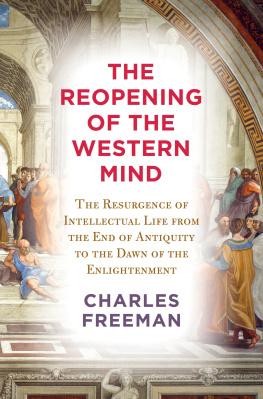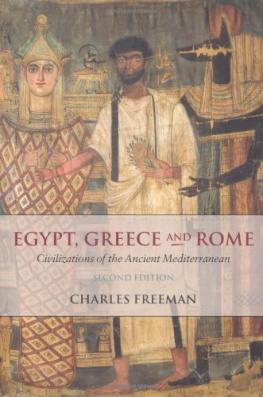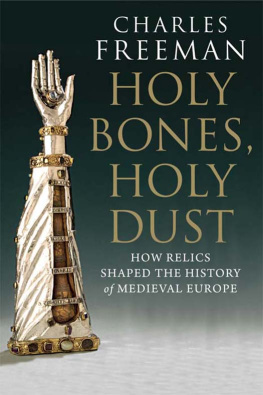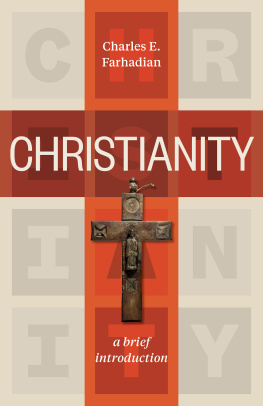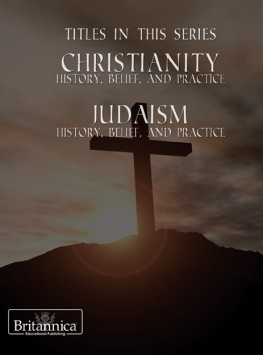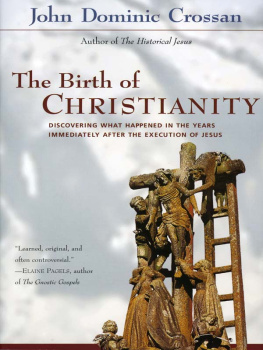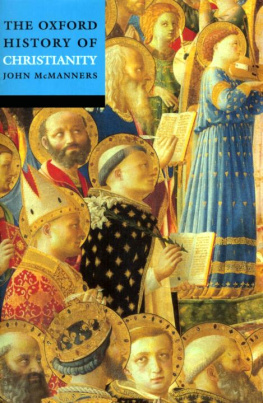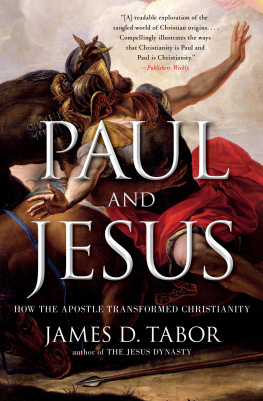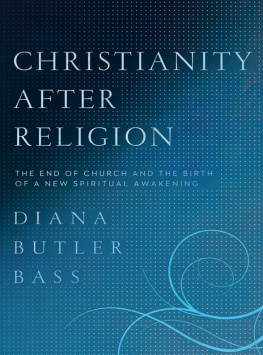A NEW HISTORY OF EARLY CHRISTIANITY
A NEW HISTORY OF EARLY CHRISTIANITY
CHARLES FREEMAN

Copyright 2009 Charles Freeman
The right of Charles Freeman to be identified as Proprietor of this work has been asserted by him in accordance with the Copyright, Designs and Patents Act 1988.
All rights reserved. This book may not be reproduced in whole or in part, in any form (beyond that copying permitted by Sections 107 and 108 of the U.S. Copyright Law and except by reviewers for the public press) without written permission from the publishers.
For information about this and other Yale University Press publications, please contact:
U.S. Office: sales.press@yale.edu www.yalebooks.com
Europe Office: sales@yaleup.co.uk www.yalebooks.co.uk
Set in Minion by IDSUK (DataConnection) Ltd.
Printed in the United States of A erica by Sheridan Books
Library of Congress Cataloging-in-Publication Data
Freeman, Charles, 1947
A new history of early Christianity / Charles Freeman.
p. cm.
Includes bibliographical references and index.
ISBN 978-0-300-12581-8 (ci : alk. paper)
1. Church history Primitive and early church, ca. 30-600. I. Title.
BR162.3.F73 2009
270.1dc22
2009012009
A catalogue record for this book is available from the British Library.
10 9 8 7 6 5 4 3 2 1
For Lydia
Contents
Illustrations
Selection of papyrus fragments from the Gospel of Matthew, Oxyrhynchus Papyri (P. Oxy LXIV 44016). Courtesy of Imaging Papyri Project, University of Oxford and Egypt Exploration Society.
Luke 16:921, early third-century papyrus (P75).
Codices of the Nag Hammadi library. Photo by Jean Doresse/ Institute for Antiquity and Christianity, Claremont, California.
Funerary stele of Licinia Amias, late third-century. Museo Nazionale Romano Terme di Diocleziano, Rome. Photo courtesy of the Ministero per i Beni Culturali Soprintendenza Speciale per i Beni Archeologici di Roma.
Fresco of Eucharistic scene from the catacomb of Saint Callistus, late second-century. From Joseph Wilpert, Die Malereien der Katakomben Roms Freiburg im Breisgau, 1903. Heidelberg University Library.
Christ as a sun god, Vatican, St Peters Basilica (Necropolis). 1990. Photo Scala, Florence.
The Good Shepherd, Asia Minor, c. 27080. The Cleveland Museum of Art, John L. Severance Fund 1965.241.
The Good Shepherd, panel in the mosaic floor at the Basilica of Aquileia. Photo by Mario Zanette.
The Good Shepherd, mosaic lunette from above the entrance of the fifth-century Mausoleum of Galla Placidia. Mausoleo di Galla Placidia, Ravenna, Italy/Giraudon/The Bridgeman Art Library.
Saints Peter and Paul saying goodbye (two men kissing), ivory buckle, third- or fourth-century. The Art Archive/Antiquarium Castellamare di Stabia Italy/Gianni Dagli Orti.
Vault mosaic with the traditio legis, Santa Costanza, Rome, c. 350. Courtesy of Saskia Ltd., Dr Ron Wiedenhoeft.
Jonah being swallowed by a sea monster, panel in the mosaic floor at the Basilica of Aquileia. Photo by Mario Zanette.
Jonah Cast Up, Asia Minor, c. 270280. The Cleveland Museum of Art, John L. Severance Fund 1965.238.
Detail of the Crucifixion, from the door depicting scenes from the Old and New Testaments, fifth-century. Santa Sabina, Rome, Italy/Alinari/The Bridgeman Art Library.
Ivory pyxis, early fifth-century. bpk/Skulpturensammlung und Museum fr Byzantinische Kunst, Staatliche Museen zu Berlin. Photo: Jrgen Liepe.
Christ enthroned among the apostles, mosaic apse of San Pudenziana, Rome, c. 400. Copyright Johannes G. Deckers, photo Franz Schlechter/Heidelberg.
Christus militans, mosaic in Archiepiscopal Chapel, Ravenna, late fifth-century. akg-images/Erich Lessing.
Sarcophagus showing scenes from the Bible, Santa Maria Antique, Rome, late third-century. Hirmer Verlag, Mnchen.
Sarcophagus showing scenes from the Passion, mid-third-century. Allan T. Kohl/Art Images for College Teaching (AICT)
Three Women at the Tomb and the Resurrection of Christ, ivory panel, early fifth-century. Bayerisches Nationalmuseum Mnchen.
Detail of the ascension of Elijah, from the door depicting scenes from the Old and New Testaments, Santa Sabina, Rome, fifth-century. Photo by Graydon Snyder.
Interior view of basilica of Santa Sabina, Rome. akg-images/Bildarchiv Monheim.
Detail of Virgin and Child, mosaic in Sant Apollinare Nuovo, Ravenna, sixth-century. akg-images/Erich Lessing.
Ivory gospel book covers from the Dittico delle Cinque Parti, late fifth-century. Copyright Veneranda Fabbrica del Duomo di Milano.
Ivory throne of Saint Maximinian, sixth-century. The Art Archive/Archbishops Palace Ravenna Italy/Alfredo Dagli Orti.
Cross of Justin II. Vatican, St Peters Basilica (Treasury Museum). 1990. Photo Scala, Florence.
Maps
Jewish and Samaritan populations
Pauls missionary journeys
Boundaries of the Roman empire
Rome and the main centres of Christianity
Preface
IN AD 30, A JEWISH PREACHER FROM GALILEE CALLED JESUS ARRIVED in Jerusalem for the Passover. A crowd of his followers had come with him and the bustle and excitement soon spread to the Jerusalem crowds. Jesus had talked of a coming kingdom, a spiritual and political revolution that would renew Israel. The authorities, the Jewish priesthood and their Roman over-lords, felt threatened by the disturbance. They arrested and crucified Jesus, the best way of publicly terrorising his followers. It appeared they had snuffed out the movement.
Somehow, in the bleak hours and days that followed, a core of Jesus followers began to conceive of him as something more than an ordinary mortal. There was talk that his tomb had been found empty and that favoured disciples had seen him risen from the dead. Then, after forty days at most, the appearances ceased, although some believed he would come again.
As the months and years passed and there was no second coming, his disciples began to speculate on whom Jesus might have been. They had a mass of Jewish titles to draw on Son of God, Messiah, Son of Man, Lord, Prophet. For a Jew none of these implied divinity. Son of God meant only one specially favoured by God; messiahship was associated with the (inevitably violent) liberation of Israel from foreign domination by one of the royal house of David. From the earliest days Christians debated and argued among themselves as to how one could find a coherent understanding of Jesus. In his anguished First Letter to the Corinthians, one of the oldest Christian texts to survive, the apostle Paul complained that his readers had divided into followers of himself, of the apostle Peter, of an intellectual, Apollos, and of Jesus now seen as Christos, the anointed one (1 Corinthians 1:1214).
This picture of Christians in debate may seem startling to some readers. All too often Christian doctrine is presented as fixed and unchallengeable, but even the slightest contact with the history of Christianity shows that this was never so. This book takes it for granted that there were competing traditions within the emerging church and explores the difficulty in ever finding any one true Christianity. In fact, it was only when the Roman emperors of the fourth century used the enormous coercive power and patronage at their command to insist on a uniform set of beliefs that one could talk in such terms.
So while, traditionally, the history of the church has been written as if the doctrines chosen by the emperors, in particular the Nicene formulation of the Trinity, were the only ones possible, I have not made this assumption here. I prefer, for instance, to highlight the impossibility of achieving any form of consensus on the nature of the risen Christ and his relationship to God. I hope this makes for an altogether more absorbing narrative and one that corresponds to the debates as they are recorded.
Next page


